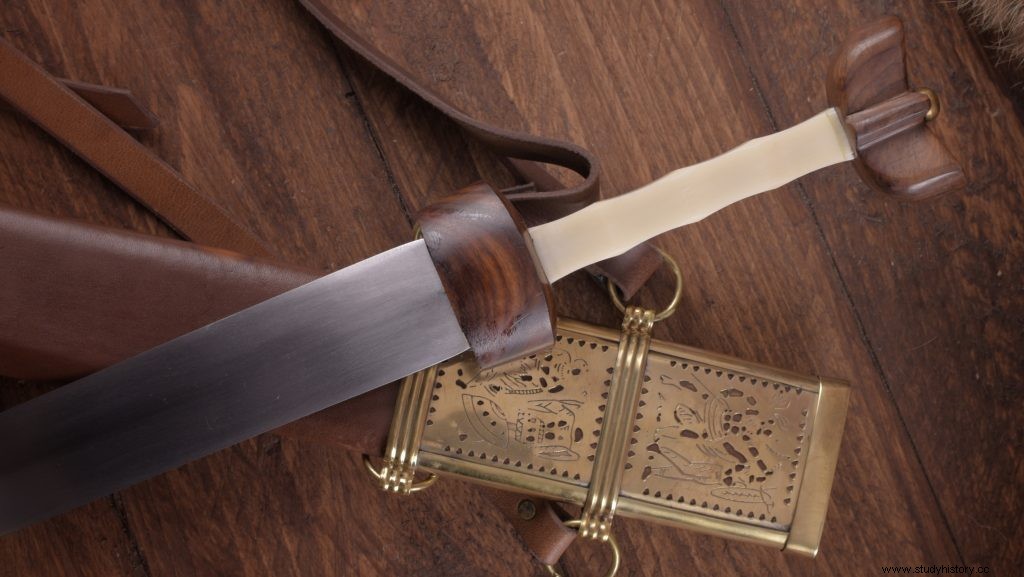The Roman spatha is one of the most well-known weapons of the Romans and describes a double-edged sword that was mainly used as a slashing weapon. Due to its low weight and one-handed use, this Roman weapon was ideal for mounted fighters and as a weapon for infantry troops.
The History of Spatha
Spatha is a Latin term denoting the broad blade that is considered an endemic feature of this sword. With a blade width of between 4 and 6 centimeters, the sword, which was 75 to 110 centimeters long, clearly differed from other weapons of this era.
Nothing is known about the exact origin, but it is assumed that the Roman weapon goes back to a sword of Celtic cavalry troops from the 1st century. If you follow this thesis, the original form of the spatha got into the Roman army through recruited warriors and was perfected there. Within a short time, the spatha spread throughout the Roman Empire and Germania.

Who used the Roman weapon?
The weight of the weapon was about one kilogram, making it ideal for mounted and walking warriors. Its length also affected its distribution, as the sword could also be wielded by smaller soldiers. One of the best-known stories of Spatha is the invasion of Charlemagne in Saxony in 772. The peasants fought with Roman weapons and, if they fell in battle, were buried with the sword.
Initially, the Roman weapon was mainly used by mounted auxiliary troops of the Roman army. In the 2nd century, the weapon also gained importance for the infantry and in the late Roman period replaced the gladius, which had been the main weapon used until then. Reserved only for wealthy warriors in its heyday, this sword soon became the main weapon used in the Roman Empire.
Different forms:advantages in use
The base of the spathe consists of a blade that was between 4 and 6 centimeters wide. The total length of the sword was between 75 and 110 centimeters including the handle, resulting in a blade length of 60 to 100 centimeters.
Depending on the status of the knight, the handle was made of horn, wood or bone. Blades used only by noble knights were decorated with ivory handles. The blade was parallel and sharpened on both sides. The marginal taper ended in a shaped, often slightly rounded tip.
In use, the spatha proved to be a practical and easy-to-wield Roman weapon. Due to its shape as a one-handed sword, it was mainly used as a cutting weapon, which was dominant from horseback or in ground combat by the Romans. Only in the time of the migration of peoples did the sword change from several narrow to a single wide hollow blade on both sides of the sword. It was also only in this era that the handle was made of metal and no longer made of wood and bone. Some special forms developed over time. However, these were less practical and did not play a significant role with the Romans. In use, the spatha proved to be one of the most practical cutting weapons of its time due to its properties and low weight.
The Spatha - Differences to other swords
Most weapons in Roman times were heavy, often unwieldy and only usable with both hands. This is where this sword with a blade sharpened on both sides and one-handed operation emerged as an innovation. Due to the greater mobility of the warriors, the Roman weapon quickly replaced other swords, such as the long sword or short swords with straight and curved blades. The difference was less evident in optics, since the Roman spatha was not a representational weapon. It became clear through the weight and the easy handling, which went hand in hand with the shape of the handle and blade as well as the materials used.
The equipment of the Romans
When you think of a Roman legionnaire, the first thing that comes to mind is the red or white tunic. The long shirt, sometimes replaced by the military coat, was combined with a belt and the actual armor of mail and helmet. Military boots, the spatha, alternatively also a dagger or a sword and the helmet rounded off the equipment.
Each warrior carried a shield, which in the Roman Empire was mainly rectangular and decorated with the insignia of the empire. The rapid spread of the Romans was based not least on their armor, which, in contrast to other warrior peoples of the same era, was perfectly forged and planned down to the last detail.
